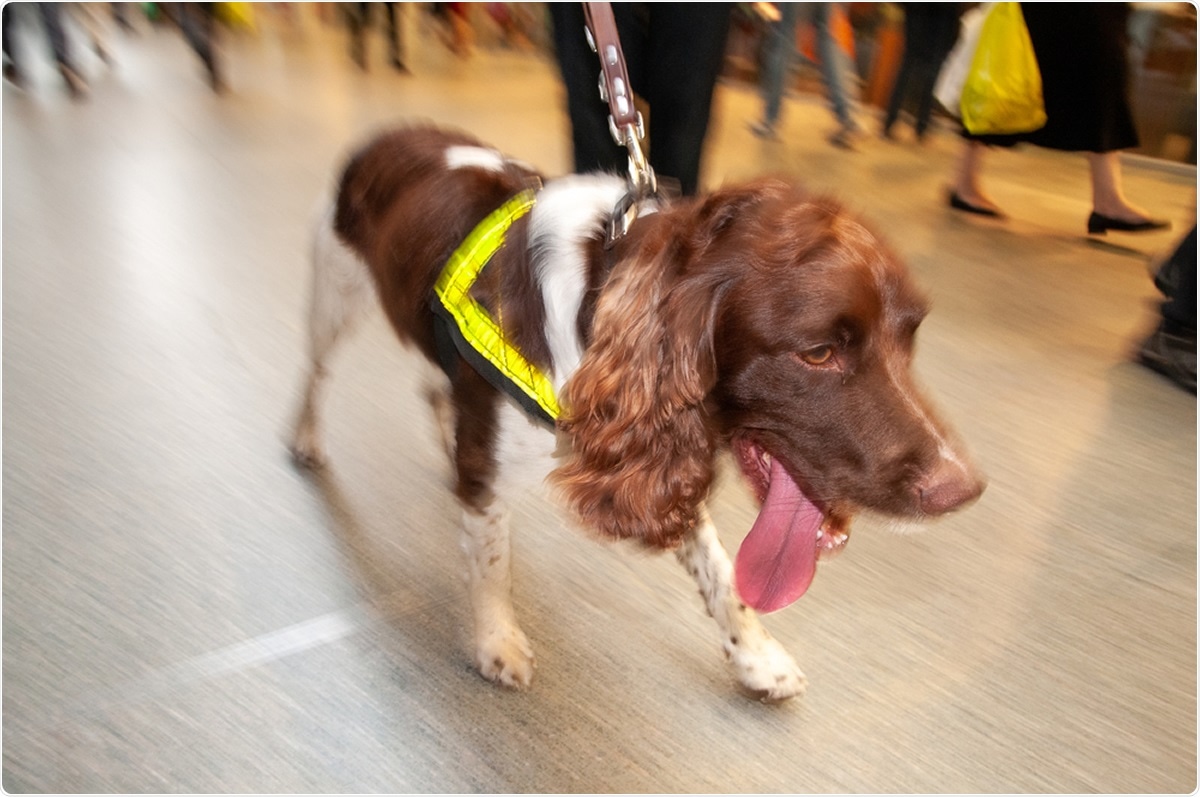Researchers in Germany suggest that sniffer dogs should be considered as an additional screening tool for detecting infection with severe acute respiratory syndrome coronavirus 2 (SARS-CoV-2) – the agent that causes coronavirus disease 2019 (COVID-19).
The team found that dogs could discriminate between saliva samples from people with and without SARS-CoV-2 infection with a sensitivity of 84% and a specificity of 95%.
The dogs were also able to detect the scent of SARS-CoV-2 infection in sweat and urine samples, with sensitivity and specificity as high as 95% and 98%, respectively, for urine samples.
Holger Andreas Volk from the University of Veterinary Medicine Hannover in Bünteweg and colleagues say the results suggest that sniffer dogs could be added to the current gold standard method for detecting SARS-CoV-2.
The team advises that dogs should be considered for rapid testing in various situations where many people from different origins come together, such as airports or concerts.
A pre-print version of the research paper is available on the bioRxiv* server, while the article undergoes peer review.

The current approaches to containing COVID-19
The primary approach to containing the COVID-19 pandemic is ongoing testing, tracing and quarantining while enough vaccines are administered to protect a sufficient proportion of the population.
The SARS-CoV-2 virus is currently detected using the “gold standard” reverse transcription-polymerase chain reaction (RT-PCR) and slightly less sensitive but more rapid tests of nasal or pharyngeal swabs and saliva.
However, “it remains unclear whether sweat or urine are also sources of viral transmission,” says Volk and colleagues.
How might dogs detect infection?
Renowned for their extraordinary olfactory sense, dogs are often deployed for real-time detection of drugs and explosives, for example.
Infectious diseases can produce specific odors through the generation of volatile organic compounds (VOCs) – products of metabolism emitted in the breath, saliva, sweat and urine.
Multiple studies have shown that dogs can detect infectious and non-infectious diseases such as cancer, malaria, bacterial infection, hypoglycemia in diabetics, and viral infection in cell cultures.
Several research groups are currently training and deploying dogs for the detection of SARS-CoV-2 infection.
In a pilot study, Volk and colleagues recently showed that dogs were able to detect inactivated saliva samples from COVID-19 patients with a sensitivity of 83% and a specificity of 96%.
However, it remains to be shown whether dogs can detect biofluid-specific VOCs or a more general change in the odor of COVID-19 patients.
What did the current study involve?
In the former pilot study, only beta-propiolactone (BPL)-inactivated samples from COVID-19 patients were used.
“The first step in the current study was, therefore, to assess whether dogs can transfer scent recognition to non-inactivated saliva samples, even when trained only with inactivated samples,” says Vol and colleagues.
Ten German armed force’s service dogs were trained for a period of 8 days to recognize the scent of SARS-CoV-2 infection using BPL-inactivated saliva samples. The researchers then tested whether the animals could transfer their smell recognition to non-inactivated saliva, urine and sweat samples from infected patients.
The animals recognized the scent of SARS-CoV-2 infection with a sensitivity and specificity of 95% and 98%, respectively, for urine samples, 91% and 94% for sweat samples, and 82% and 96% for saliva samples.
“After only eight days of training, dogs were not only able to immediately transfer their scent detection abilities from inactivated to non-inactivated saliva samples, but also to sweat and urine, with urine having the highest sensitivity of 95% and specificity of 98%,” writes the team.
The researchers say the findings show that global, non-tissue-specific SARS-CoV-2-associated VOCs are released across different bodily secretions.
What does the team advise?
The current study suggests that dogs can be safely trained within little more than a week to become reliable SARS-CoV-2 detection dogs, says volk and colleagues.
“Sniffer dogs should be considered an addition to the gold standard RT-PCR, for rapid testing in situations where great numbers of people from different origins come together,” they write.
“Further work, especially under real-life conditions in settings where many individuals have to be screened is needed to fully evaluate the potential of the dog detection method,” concludes the team.
*Important Notice
bioRxiv publishes preliminary scientific reports that are not peer-reviewed and, therefore, should not be regarded as conclusive, guide clinical practice/health-related behavior, or treated as established information.
- Volk HA, et al. Scent dog identification of SARS-CoV-2 infections, similar across different body fluids. bioRxiv, 2021. doi: https://doi.org/10.1101/2021.03.05.434038, https://www.biorxiv.org/content/10.1101/2021.03.05.434038v1
Posted in: Medical Science News | Medical Research News | Disease/Infection News
Tags: Body Fluids, Cancer, Cell, Coronavirus, Coronavirus Disease COVID-19, Drugs, Hypoglycemia, Infectious Diseases, Malaria, Medicine, Metabolism, Pandemic, Polymerase, Polymerase Chain Reaction, Research, Respiratory, SARS, SARS-CoV-2, Severe Acute Respiratory, Severe Acute Respiratory Syndrome, Syndrome, Transcription, Veterinary, Virus

Written by
Sally Robertson
Sally first developed an interest in medical communications when she took on the role of Journal Development Editor for BioMed Central (BMC), after having graduated with a degree in biomedical science from Greenwich University.
Source: Read Full Article


